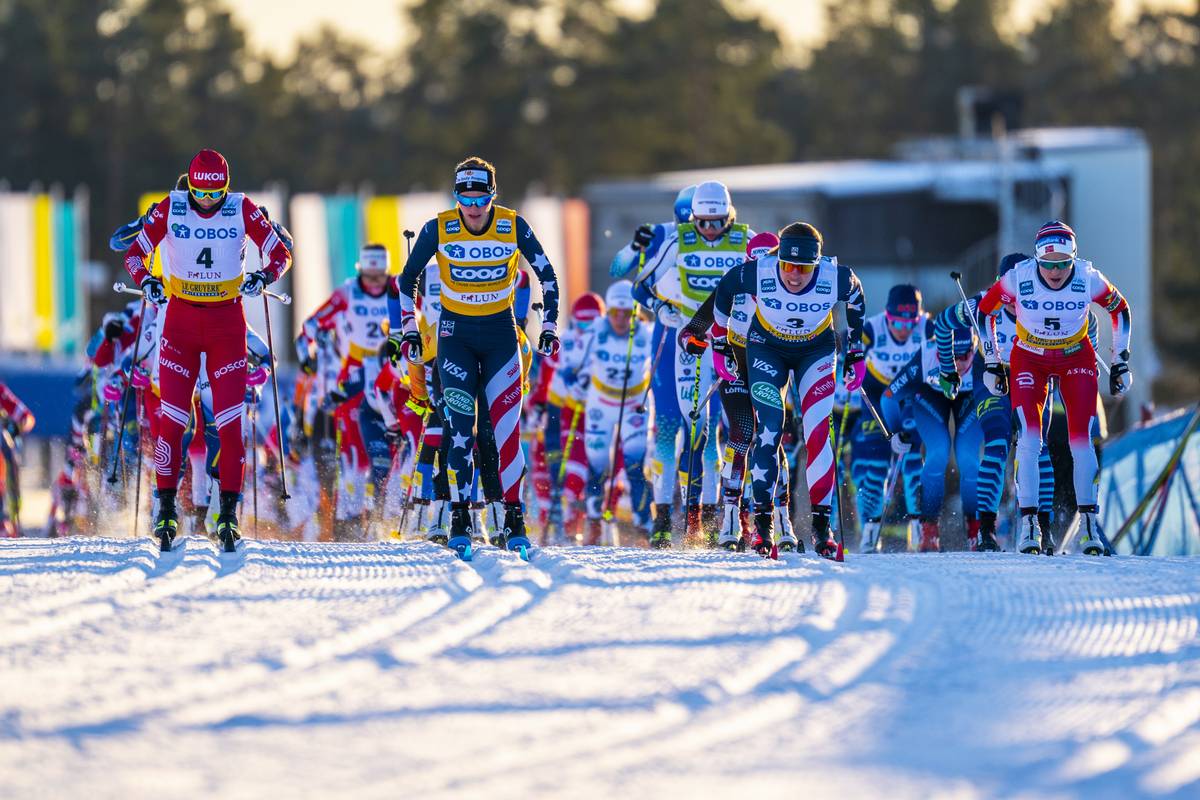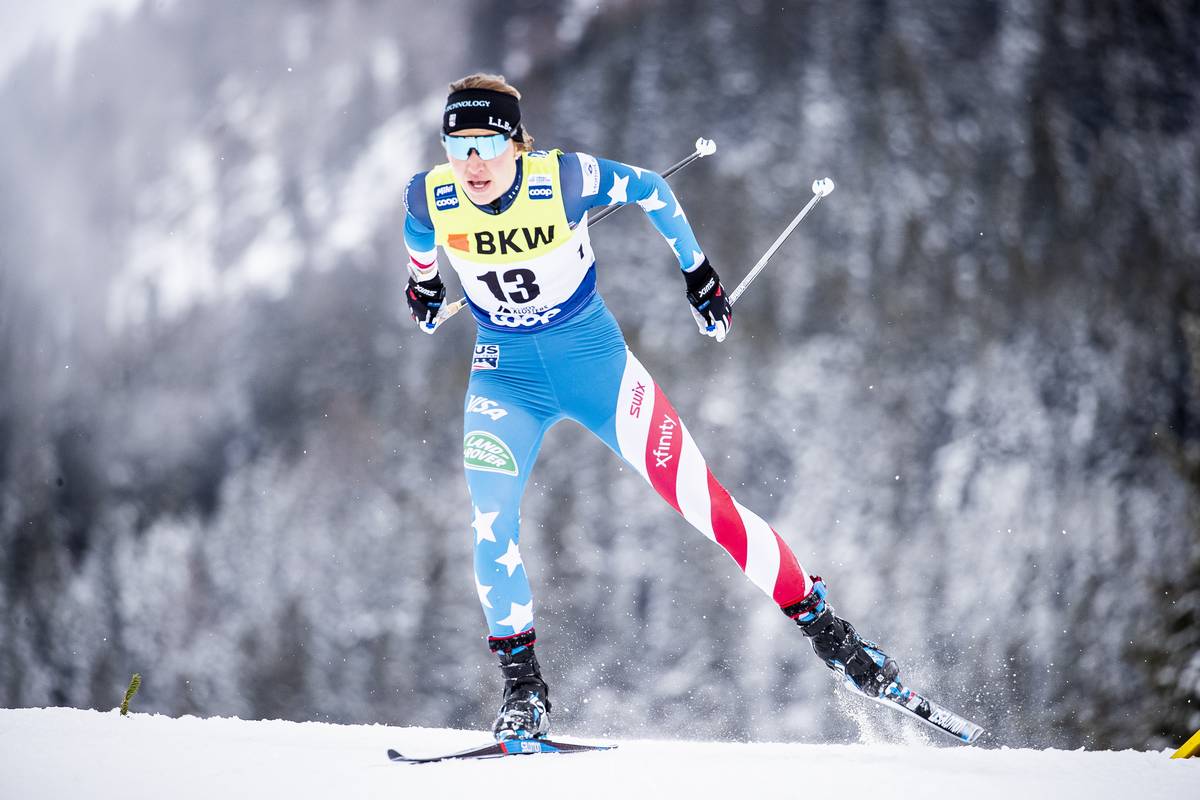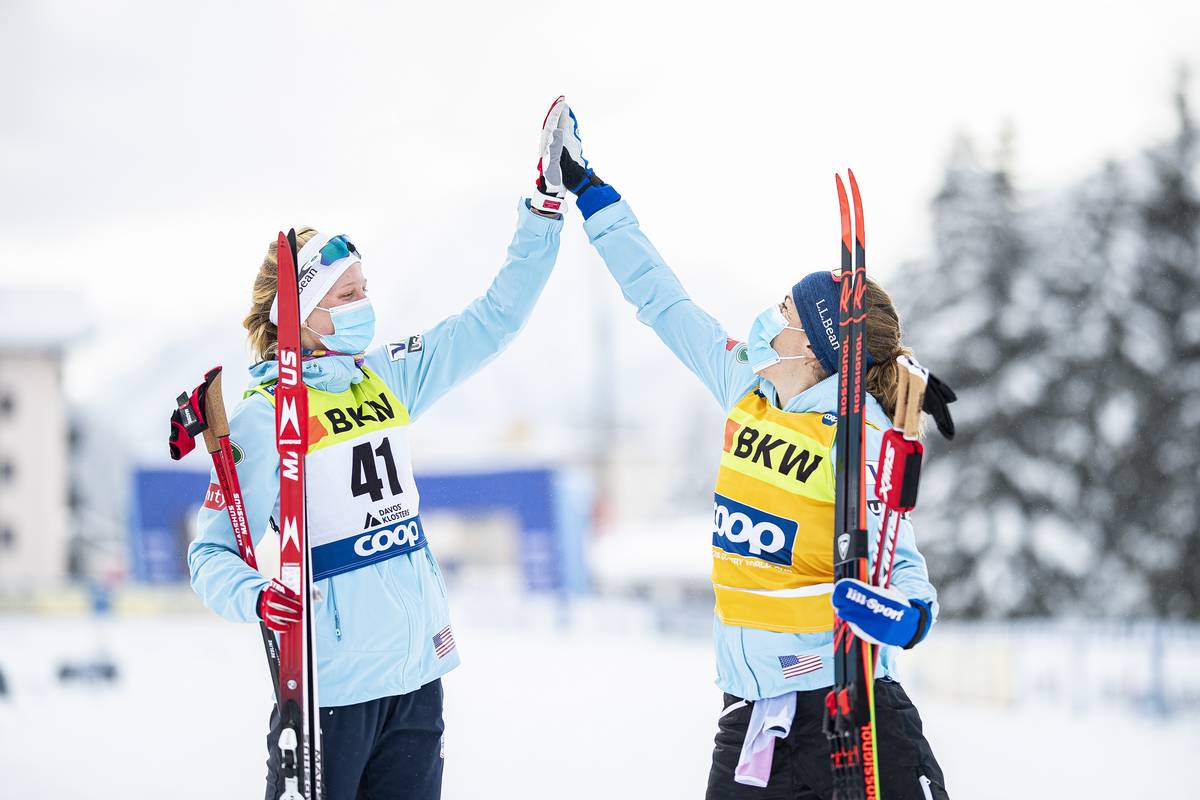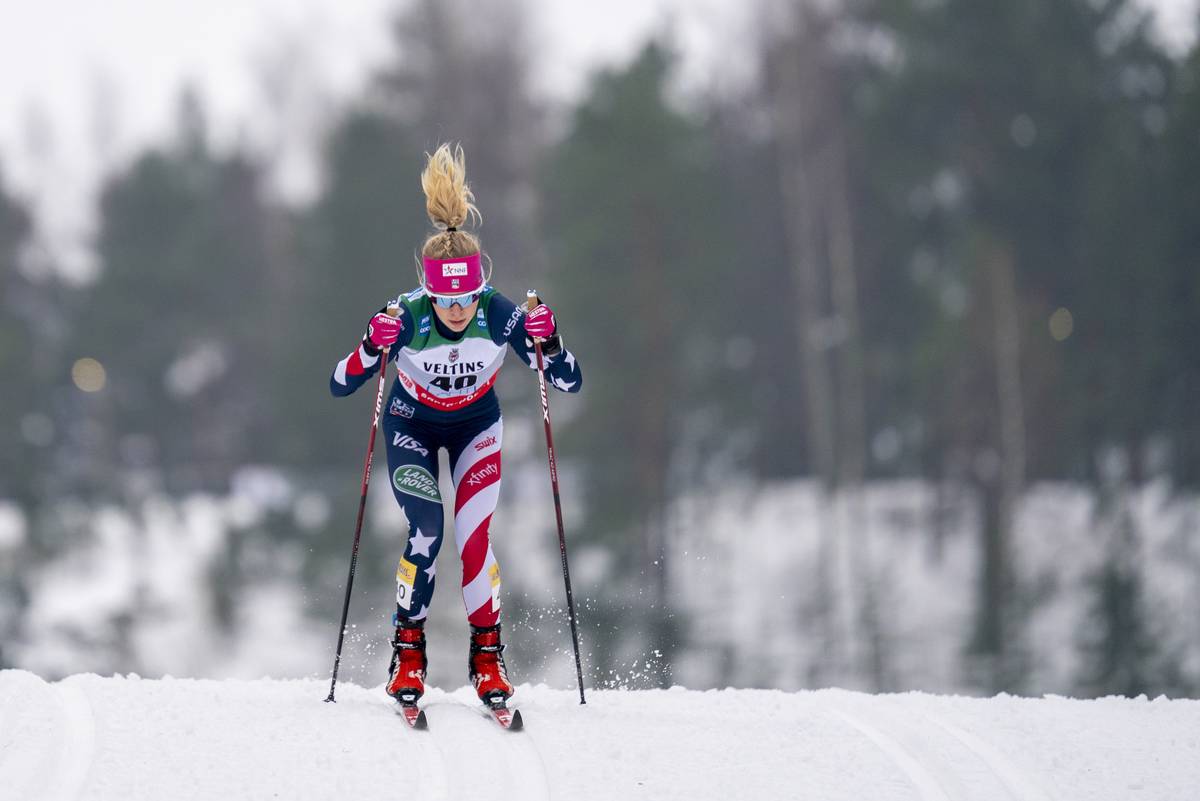
This article is part of a series regarding female athlete specific physiology and nutrition. To get started, you can find a primer on the menstrual cycle here and listen to this podcast on Nordic Nation discussing female athlete specific nutrition with registered dietician and professional runner Maddie Alm. The survey analyzed here is an extension of the conversation with Guro Strøm Solli on her research on female athlete specific physiology and effects that the menstrual cycle has on training and performance, which can be found here.
Over the last five years, Dr. Stacy Sims book ROAR and the work of the team behind the FitrWoman app, cited by the US Women’s National Team soccer athletes as a key to their World Cup victory, have sparked conversations on how female athletes might take their unique physiology into account to optimize their training. However, the application of this research is far from ubiquitous. Research into the implications of hormonal fluctuations across the menstrual cycle to strength, inflammation, fatigue, nutritional demands, and the myriad of other training considerations is relatively new to the exercise physiology scene, partly because women tended to be excluded from research as their cycle might cause anomalies in the data.
While this area has seen a boom in research over the last decade, the individual variation women experience coupled with the prevalent use of various forms of hormonal contraceptives makes it challenging to provide concrete generalized recommendations that will serve all female athletes. However, as the area gains more attention, trends have emerged that may help athletes who feel they could benefit from aligning their training or nutrition to their cycle.
Some examples include periodizing hard strength training and intensity sessions earlier in the cycle when the ratio of estrogen, a steroid hormone, to other sex hormones is optimal, including a greater emphasis on hydration and electrolyte supplementation in the later half when elevated levels of progesterone trigger a rise in body temperature, or consuming anti-inflammatory foods during the pre-menstrual phase to mitigate inflammation and other PMS symptoms.
For women desiring to troubleshoot or better attune their activity to their cycle, tracking is recommended as a first step to illuminate patterns in mood, fatigue, sensations during training, et cetera. Diving into the information presented in ROAR or tracking tools like the FitrWoman App that present findings on how training or nutrition might be aligned to the cycle may be a good next step to access information on existing research. Then, through self-experimentation or communication with a coach and/or registered dietician to apply these strategies, an athlete can learn which strategies might make the greatest impact in optimizing their training and overall health.
As the topic of female-specific physiology gains traction in exercise physiology research circles, we began to ask how it is being used amongst elite athletes? And, how does this apply to the FasterSkier community?
In January, FasterSkier spoke with former World Cup athlete and exercise physiologist Guro Strøm Solli regarding her recent article “Changes in Self-Reported Physical Fitness, Performance, and Side Effects Across the Phases of the Menstrual Cycle Among Competitive Endurance Athletes” published in September 2020 in the International Journal of Sports Physiology and Performance. The research presented in the article included survey data collected from 140 respondents, all of whom were elite-level cross country skiers and biathletes.
To look for parallels to this research closer to home, FasterSkier distributed a similar anonymous survey to assess the extent to which elite American skiers and biathletes track their menstrual cycle alongside their training, adjust based on cycle, experience side effects, and feel they have sufficient access to knowledge in this area. FasterSkier’s survey can be found here for reference.
And now for the takeaways: the similarities to Solli’s research and the trends in responses, including featured responses that best represent common themes or differing viewpoints, and what coaches and athletes might gain from this insight.

The Basics:
The survey saw 16 respondents, all of whom were national team members and/or trained with elite-level clubs such as Alaska Pacific University, Stratton Mountain School, Craftsbury Green Racing Project, or the Bridger Ski Foundation Pro Team. 68.8% were between the ages of 22 and 30, with 18.8% in the category of 18-22, and 12.5% between 30-35 years old. 62.5% of these athletes experienced 8-12 menstrual cycles per year, 6.3% experienced 4-7 cycles and 31.% fewer than 4.
The respondents were evenly split between hormonal contraceptive users and non-users (this question was not further broken down by type), and of athletes who used a tool like FitrWoman to track their cycle. Of the 50% who used a tracking tool, 87.5% had done so for 1-3 years, with the remainder of athletes tracking for less than one year.
Q: In your experience, what affect, if any, do the phases of your cycle have on your training adaptations and/or performance?
In line with Solli’s research, most athletes identified the week leading up to menstruation as the most common to experience detrimental symptoms, such as bloating, fatigue, lethargy, or mood changes. Some athletes also expressed positive impacts, which are featured in the next section. Three athletes expressed that due to the nature of ski racing every weekend during the winter, they either chose not to focus on the impacts of the cycle since they would need to be mentally and physically primed to race during all phases, and maybe preferred not to plant the seed that there might be factors that may hold them back on race day.
- “I have noticed that when I feel unwell due to my period, I am less inclined to train hard; however, I think if anything it is more mental than performance related (more related to just feeling unwell, tired, PMS symptoms, etc.)”
- “I don’t really change anything or adapt my training during a cycle, and haven’t noticed an impact on my performance.”
- “I use the pill and often find my best races are when I’m not taking it (I.e. when I’m on my period).”
- “Hard to really see patterns but sometimes detect a few. We have to train and race through all phases, so it’s detrimental from a mental perspective to think that any phase, in particular, is “bad” – they’re just different. I try to be extra nice to myself with training/rest/shortening workouts if I’m going through a rough phase of a cycle, which for me is usually in the lead up and when I have my period. However learning that the time on your period is when your hormones are most ideal for high performance has helped me get through it, because even though I may be feeling icky, I know that my body should be ready to go underneath it.”
Q: During which times within your cycle do you feel your performance potential and/or ability to train hard and recover well are maximized? Explain.
Most athletes indicated that the best sensations in training and racing occurred in the first half of their cycle, after their period had started. During menstruation, female sex hormones estrogen and progesterone are low, then estrogen independently rises in the second week of the cycle. Both “ROAR” and the FitrWoman app identify this as a sweet spot for high intensity training, heavy strength training, and decreased recovery time between sessions.
- “I tend to agree with the FitrWoman app predictions, of increased strength performance during my period and decreased activation beforehand. I know that I’ve had very strong races at all times of my cycle so I’m not sure it affects the very top end performance, but more affects my body’s willingness to activate and work hard. My main concern is dealing with cramps during my period. I have to take a lot of pain medication, which sometimes doesn’t seem good for racing or for general health when combined with hard efforts. Cramps also make it very hard to activate my lower abs and have stability through my torso, which makes it difficult to ski well unless I’m very motivated.”
- “I can tell that I’m more apt to lift well in the weight room while I’m on my period, after the cramps are gone. I think that also correlates to racing well. The wild mood swings before my period can occasionally be helpful in racing motivation, i.e. when I can be angry and keyed up. But moods swing both ways.”
- “Right when my period starts and the week after, I feel less bloated and I tend to feel faster in training. I don’t notice a difference in recovery time, but in overall feelings I tend to feel better.”
- “There are so many variations in a normal training cycle, and just from life, that I wouldn’t say I noticed any particularly maximized phases related to my cycle. However it is easier to embrace hard training and expect normal highs and lows when I’m not on my period, so the other 3 phases I guess.”
Q: During which times within your cycle do you feel your performance potential and/or ability to train hard and recover well are most diminished? Explain.
Thirteen of the respondents identified the week leading up and the first few days of their period as the time their training and overall feelings were most impacted, both physically and mentally. Note that registered dietitian and professional runner Maddie Alm, who is concurrently collaborating with coaches and experts on a project surrounding female physiology, offered suggestions for mitigating the effects of PMS during her interview on NordicNation.
- “I usually feel pretty drained mentally before and during my period, as well as feel effects on my body (bloating, cramps, cravings). Right after is when I feel the best since my body is back to ‘normal’.”
- “When I am on my period- I just feel very tired, irritable, bloated, and often relatively nauseous. Even with an IUD and not having normal cycles, I can feel hormonal fluctuations that make me feel unwell.This overall effect on my mental state makes me less motivated to train hard, but I am not sure if in terms of performance or recovery I actually perform worse or am less capable of adequate recovery (like in terms of race results and intervals I don’t think my performance is diminished while on my period, I just feel worse).”
- “Sometimes when I’m on my period, it feels like it affects my ability to train hard, to perform well, and to recover, as well as my mood and outlook on life. This can be in the few days leading up to the cycle starting, and the few days when it’s happening. However it doesn’t happen every month – while I get my period every month, the intensity and difficulty of it vary significantly. Unfortunately, I haven’t been able to track any patterns with this, otherwise, I would always do what makes it less severe. And as I mentioned before, hormonally the body is strong when you’re on your period, so I try to give myself extra positive thinking, pep talks, shorten workouts, and not be too hard on myself if I’m not super fast in a training session on the bad months, because that’s just what happens. Most of the time if I am gentle on myself I can still perform quite well, but there have been notable occurrences when I’ve had terrible performances that are almost directly attributable to feeling terrible from the intensity of my period.”
- “Before and during my cycle it is difficult to recover because I experience mood swings that affect the ability to recover properly. I often use ibuprofen to deal with cramps which I feel sometimes compromises how my body feels during training.”
Q: What adjustments, if any, do you make to align your training and/or nutrition with your cycle? Examples could be: postponing or increasing recovery between hard sessions, increasing volume or intensity during a specific phase, increasing/decreasing carbohydrate or fluid intake, etc.
No athlete reported strategically aligning her training or nutrition to their menstrual cycle, though several responses included the idea of listening to their body and dialing back when needed.
- “I don’t adjust because I have to race every weekend, and I want to be used to having to perform no matter what my body is feeling. That said, I always try to have good hydration and make sure I’m adequately fueling my body.”
- “I think nutritional adjustments could be made to make me feel less bloated and nauseous, but I would need education in this area (and I think there is a really big need for it). I think that much of the negative effects are from feelings of nausea, cramps, etc.- so if there are things that could be done nutritionally to help, that would be great. In terms of adjusting training, I think it’s more difficult because a race schedule won’t adjust to your cycle so it’s good to get used to pushing hard during different times of your cycle. However, if it were found that there is a training benefit associated with training a certain way during different times of your cycle (i.e. intervals at a certain time, etc.), I think it could be an awesome training tool… if only more research were done in this area!”
- “I mostly look at it mentally. I don’t make any adjustments to my training and/or nutrition, however, when I’m feeling sluggish or low-energy I reflect if this could be because of my period. Then I try to justify it and remember that it will only last a few days and that I shouldn’t be too hard on myself.”
- “I do notice that I need to eat more during PMS, so I try to follow that. I also try to let down after my period and eat less when I don’t need as much. We don’t officially change training, I guess I listen to the Fitr App about when it’s a good idea to reach a little in the weight room, but mostly I micro-adjust training to how I feel.”

Q: Do you communicate with your coach regarding how you feel during different phases of your cycle? If so, explain how you and your coach use and discuss that information.
Thirteen athletes responded that they do not communicate with their coaches about this topic, though some added that they did feel they could if they were to initiate the conversation. The remaining three athletes state that they sometimes or occasionally talked with their coaches about their cycle, usually when it pertained to feeling negative side effects that impaired their training that day.
- “I do not, but I would be comfortable doing so, since both my coaches are women. I would address if my period cramps were making me nauseous.”
- “Sometimes I’ll explain that I need space or less coaching if I’m feeling down or off because of my cycle, and my coach has always been really great at understanding and respecting that.”
- “No, I don’t communicate. I think I could if I needed to, but I also have a male coach and it is not brought up much for awkwardness level. My teammates and I communicate openly about periods and if someone has cramps, etc. and I find their support and ideas as helpful as a coach.”
- “Most phases are just normal life and training, ups and downs, but my coach and I definitely talk about it when I’m on an intensely bad cycle. Sometimes if it falls on an intensity day I’ll do fewer intervals than otherwise planned, or else use it as a wake-up workout rather than really pushing hard. More often I’ll carry on as planned, because ups and downs of feeling are just part of the training life.”
Q: What information, if any, have you received or read regarding how normal hormonal fluctuations may influence training adaptations, nutritional requirements, and performance?
Five athletes reported that they had never received information about the menstrual cycle as it pertains to female athletes. Six athletes expressed they had received some information, and five expressed that they had attended presentations put on by U.S. Ski & Snowboard or regularly used the FitrWoman app as an educational resource.
- “None! Ever! Huge need for this!!!!”
- “I have received information but chosen to ignore it.”
- “The Fitr App mentions characteristics of each phase, like when it’s good to train heavy weights for example. I generally agree with it. I’ve been to one lecture by the Fitr App creators at US Ski Team camp, which gave me the most information I’d ever gotten. Previously I’d noticed some trends myself, but didn’t understand the different phases and what hormones caused which effects.”
- “Working with Fitter Woman and using their app, I’ve learned that these fluctuations in body temperature, sleep and recovery are normal, which helps me to be less concerned by them and be able to focus on performance. It was also super helpful to learn that right before my period starts I’m most at risk for getting sick, so I try to be extra careful with my immune system that week.”
- “I have been tracking with the Fitr app the past year plus, and that has some helpful suggestions. I eat and hydrate with care and healthy habits all the time, so I can’t say that I’ve made many changes as a result of tracking or reading about it. Sometimes I do notice cravings that make sense in the context of the cycle. As I mentioned before, I prefer to believe that there are good and bad parts about each phase, and as there are ups and downs in all parts of life, it’s something I adapt to on the fly while training and don’t make too big a deal about. As we nordic racers will compete during the entire winter and just about every weekend, it’s not possible to race in the same phase of the cycle every time – we have to be adaptable and ready to handle what the body throws at us, and I find that is mostly mentally knowing that it might feel bad but I can still have a great performance if I ease into my warmup and maybe recover a little extra.”
Q: Additional comments?
- “I think effects on the body and overall experience of a cycle is not discussed enough in the ski community. I have had some ‘girl talks’ with teammates or coaches but nothing more than once or twice a year, and nothing significant to make a difference in how I train or deal with it.”
- “I would like information on nutrition/hydration/recovery and other ways I can deal with cycle side effects. Some simple tips to start and maybe more info for those interested. I also think noting birth control methods and effects for athletes would help young women make choices that they often go blindly into.”
- “This is definitely a great survey and a topic that should be discussed much more frequently!”
- “I’ve always been curious about the effects of hormonal birth control on performance. The hormonal birth control I’ve tried (Sprintec pill and NuvaRing) changed my personality somewhat, made me more compliant and non-ambitious or depressed. They also made me gain weight. None of those were good things for skiing, so I’ve been unable to find a good solution. The Fitr App lecture talked about progesterone-only options being better, but I haven’t been able to find a good one. Apparently, I’m not a good candidate for an IUD, and wish there was another very low dose progesterone-only option. I also feel that people with ‘overly healthy’ menstrual cycles are a minority at my level in this sport, so I don’t have a lot of other athletes with heavy periods to brainstorm with…”

Conclusions:
So, what can we gain from these responses?
It is noteworthy that over 80% of the responses stated that they had never spoken with a coach regarding their cycle or female physiology. As absence or irregularity of a menstrual cycle can also be thought of as a “canary in the coal mine” for the damaging condition referred to as Relative Energy Deficiency in Sport (RED-S), providing resources and initiating conversations about this topic might help female athletes not only optimize their athletic performance but also prioritize their overall health and wellbeing.
One athlete commented that it was awkward to discuss her cycle with her coach as he was male, one said she did feel comfortable because her coach was female, and another commented that their conversations about the topic were in the form of “girl talk” with teammates. This is consistent with Solli’s journal article, where athletes were quoted as citing “because he is a man” as a reason for not discussing the topic with their coaches. The respondents in this article also expressed that their coaches lacked general knowledge about the menstrual cycle and the differences between male and female athletes. “I think there may be differences due to the MC that he is not aware of,” one athlete wrote.
Female coaches are underrepresented at the elite level. In the United States, roughly 20% of Division 1 ski programs are led by a female coach, and the Craftsbury Green Racing Project stands alone as the only postgraduate elite team with a female coach, namely Pepa Miloucheva. U.S. Ski & Snowboard has recently hired a female coach to lead the D-Team, Bernie Nelson for the 2010-2020 season, who passed the baton to Kate Barton.
Though male coaches can certainly be informed in the subject matter and engage in appropriate conversations with their athletes about this topic, per the athletes’ comments, more effort may be required to normalize these conversations. (Read how Diljeet Taylor, head coach of the 2023 NCAA title winning BYU women’s cross country running team, approaches these conversations with her athletes head-on in this Runner’s World article.)
Coaches should educate themselves on these topics to help support their athletes and, if they do not feel comfortable initiating conversations with athletes directly, consider bringing in professionals to provide education to their athletes. Ensuring females are represented in a program’s coaching or support staff, or relying on female team captains to initiate these conversations may also be valuable.
As we wrap up this series (at least, for now), we remind readers that this is an evolving topic as the impacts athletes experience take place on a spectrum and research is ongoing. We hope this information has started conversations, given women tools to start their own inquiry and self-experimentation, and raised awareness for the work being done to learn more about the female athlete body.
buy albuterol inhaler,buy combigan online,buy chantix,buy voltaren gel online